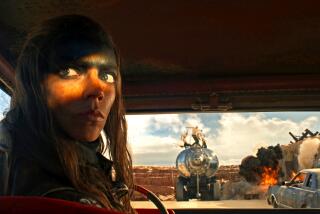MOVIE REVIEW : IMAX Views Antarctica’s Chilling Beauty
- Share via
SAN DIEGO — The latest IMAX offering at the Reuben H. Fleet Space Theater opens with a panoramic view of a seething mass of ice, a bleak and desolate expanse that fills the huge, domed screen. Light glistens off the water and glaciers as a cutter blasts a path through the ice.
“It’s summer,” the narrator intones. “It’s midnight. We are headed south.”
This is “Antarctica,” a visual exploration of the world’s coldest, highest and driest continent, opening tonight at the Fleet.
Not long ago, narrator Alex Scott notes, “Antarctica was as remote as the moon,” and, while man’s ability to visit the area has improved dramatically, it is still an alien place.
The IMAX format rewards filmmakers able to find visually stunning subjects, and it is unlikely that anyone will find a topic more breathtaking than Antarctica. Bigger than the United States, with ice covering 98% of its surface and temperatures dropping as low as 76 degrees below zero, the continent is foreboding. Although it is practically devoid of wildlife, some creatures nevertheless survive in its horrendous conditions.
Even man has been able to stake out a small foothold. More than 50 scientific research stations, operated by about 40 countries, operate in Antarctica. Their research helps provide clues to shifts in the world’s climate and other key environmental changes, the film notes.
Still, in many ways, we know as much about the moon as we do about Antarctica, where creatures evolve and survive in subzero temperatures and the land mass shifts and reforms on a regular basis.
“Antarctica reminds us again that we have scarcely begun to understand our planet,” Scott says.
Early efforts to reach the South Pole provide a loose structure for the film, which follows the heroic and seemingly insane attempts by Norwegian Roald Amundsen and British explorer Robert Falcon Scott in the early 1900s. Pictures showing the two men with their crews, wearing rags and huddled in wood shacks, make it seem inconceivable that they crossed hundreds of miles of ice to reach their goal. (Robert Falcon Scott and four of his men died on the return trip.)
But “Antarctica” is not a film about the early explorers; their stories merely provide historical context. Modern-day South Pole explorers use radar, helicopters and other state-of-the-art equipment to conquer the continent--aids that make Antarctica no less dangerous or foreboding.
As with all IMAX films, the visual imagery is the key to captivating the audience. And “Antarctica” has more than its share of stunning shots.
Aerial footage provides a bird’s-eye view--literally--of the huge glaciers. The bulky IMAX cameras are taken into crevices hundreds of feet deep. Huge, glistening stalactites of ice could have been taken from some Hollywood horror film--maybe “Return of the Ice Zombie”--but they are real and splendid, helping to give the film a chilling glow.
The underwater footage is perhaps the most breathtaking, showing penguins and seals dancing in the icy setting, in water incredibly clear and blue. Submerged ice packs and gliding seals, the light refracting through the ice ceiling, help give the scenes a surreal, unreal look.
“This is where Antarctica hides its color and its complexity,” narrator Scott says.
Even in the midst of all that beauty, the filmmakers never let the audience forget the omnipresent elements that make survival difficult in the frozen wasteland.
“Diving here is agony for the first 20 minutes,” Scott says. “After that it becomes dangerous.”
Aside from footage shot in a crystalline cavern inside a glacier, few of the shots make the viewer sit up and say, “Gee, how did they get that?”--a common reaction from IMAX audiences. But there are enough cute segments of penguins and sweeping views from helicopters to more than satisfy the dedicated IMAX fan.
The end result is a visual feast that is both eerie and enchanting. “Antarctica” is a powerful film that, to its credit, will cause the audience to leave the theater feeling cold.
“Antarctica” screens daily at the Reuben H. Fleet Space Theater in Balboa Park. Admission is $5.50 for adults, $4 for seniors and $3 for juniors (ages 5-15). Children under 5 are admitted for free. For show times or more information, call 238-1168.
More to Read
Only good movies
Get the Indie Focus newsletter, Mark Olsen's weekly guide to the world of cinema.
You may occasionally receive promotional content from the Los Angeles Times.









